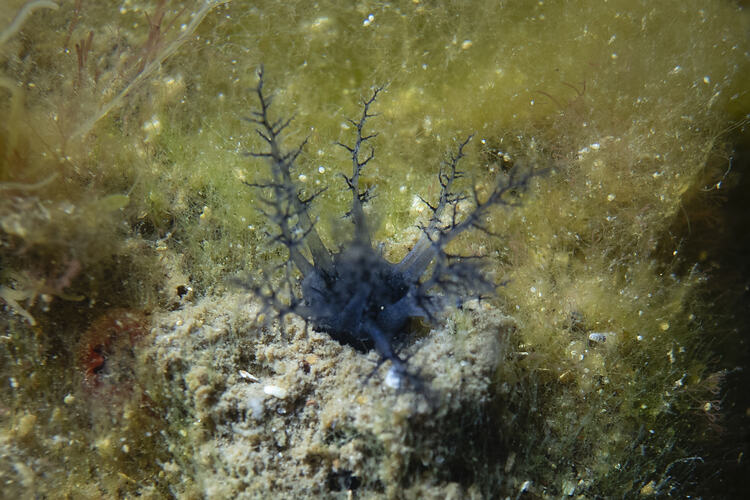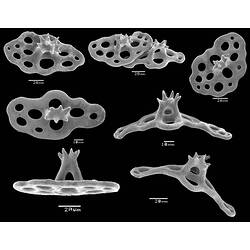General Description
Firm, fusiform (spindle-shaped) body, with upturned oral and anal ends; no anal scales; thick body wall; deep purple-black orally and anally, though dark colour obscured in body by complete cover of white tube feet; tube feet paired to multiple rows radially, and scattered inter-radially; 10 dendritic tentacles, ventral 2 smaller; body wall ossicles tables with two-pillared spires, distally spinous and joined at the top with a single cross-bar; tentacle ossicles rosettes and rare rods; up to 35 mm long and 11 mm wide.
Biology
Thyone nigra is typically found buried vertically in sand or soft sediment at 2 to 20 m, its dark tentacles are often the only part of the animal visible. As a suspension feeder the branching tentacles of Thyone nigra are extended into the surrounding water to gather and potentially filter organic matter before eating. As with most sea cucumbers, tiny calcareous deposits known as 'ossicles' help to give structure to the body wall and are often diagnostic. However, in the Thyone genus the table-shaped ossicles tend to dissolve with age which can make identification difficult.
Originally described in 1915 from a specimen found off South Australia, distribution of this species has since been extended across southern Australia including Tasmania, Victoria and Western Australia along with South Australia. Thyone nigra is considered a vulnerable species, with its current conservation status listed as 'endangered' under Victoria's Flora and Fauna Guarantee Act.
Distribution
Southern Australia (including Western Australia, South Australia, Victoria and Tasmania).
Habitat
Found in temperate reef areas buried vertically in sand or soft sediment, usually at depth of 2-20 m.
More Information
-
Animal Type
-
Animal SubType
-
Fast Fact
As this species typically buries itself in the sand you will usually only spot it from its protruding black, branching tentacles.
-
Brief Id
Dark, cucumber-shaped body, complete covering of white tube feet, 10 dark/black dendritic tentacles often protruding above sand.
-
Maximum Size
3.5 cm
-
Habitats
-
Diet
Organic matter
-
Endemicity
-
Conservation Statuses
CITES: Not listed, FFG Threatened List: Endangered, EPBC Act 1999: Not listed, IUCN Red List: Not listed
-
Depths
Shallow (1-30 m)
-
Water Column Locations
On or near seafloor
-
Taxon Name
-
Scientific Author
Joshua & Creed, 1915
-
Common Name
Sea Cucumber
-
Phylum
-
Class
-
Order
-
Family
-
Genus
-
Species Name
nigra



